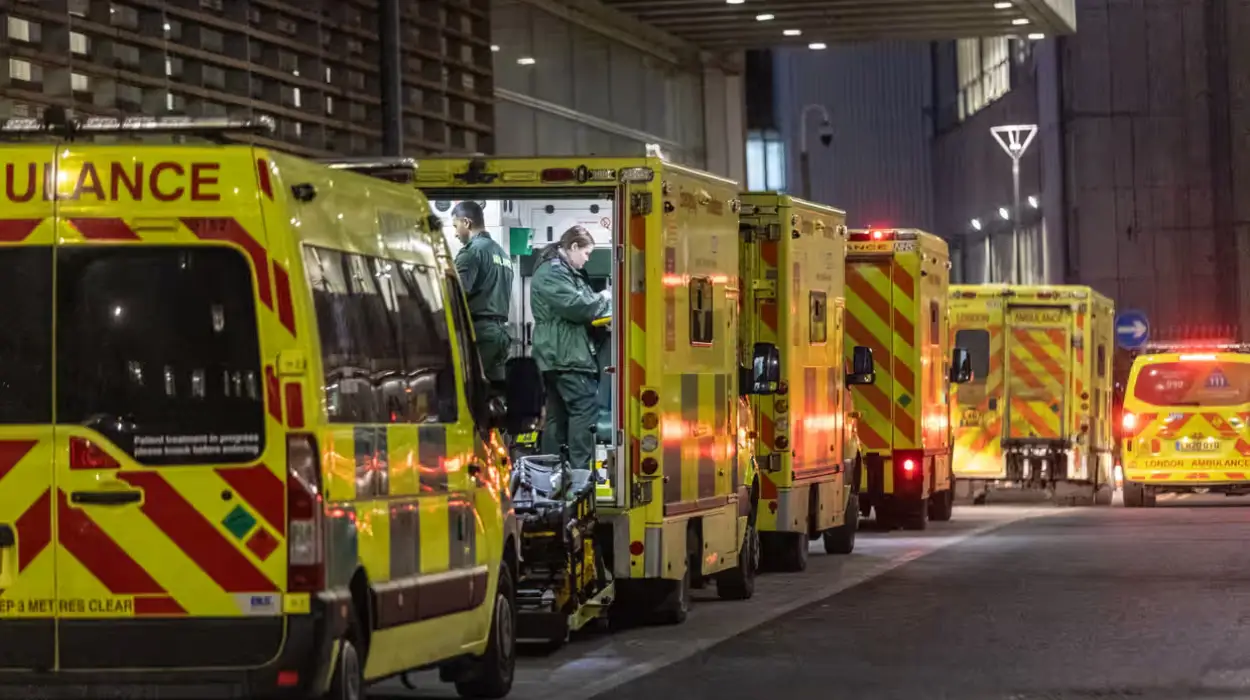UK (Parliament Politics Magazine) – Long delays at A&E are forcing paramedics to care for patients in ambulances, with fatal consequences, as surveys show up to 20 ambulances waiting outside.
As reported by The Guardian, a survey by Unison highlights that paramedics in England are observing patients die in ambulances due to prolonged delays outside emergency departments.
The growing number of hospital patients has led to queues of up to 20 ambulances being stuck outside casualty wards in certain locations.
What did Unison reveal about ambulance waits?
A survey of nearly 600 ambulance workers highlights the impact of waiting times on patients and the crews providing care. Unison has raised concerns over the growing trend of “car park care,” where hospital medical staff are forced to treat patients in the back of ambulances due to a lack of available space.
Over 77% of paramedics and emergency medical technicians have indicated that they have been forced to provide care to individuals in the back of ambulances last year, often while waiting outside emergency departments.
A significant 68% of paramedics have spent time waiting in hospital corridors or elsewhere, with one paramedic often tasked with looking after multiple patients to free up their colleagues for additional emergencies.
The survey reveals that two-thirds of paramedics also noted that patients’ conditions worsen during extended waits, with one in 20 (5%) stating that people have died in their care due to delays in admission.
According to a survey of 588 staff conducted in February and March, around one in seven respondents (16%) have spent more than 12 hours waiting outside emergency departments. At least 53% reported experiencing delays of more than six hours.
What did Gavin Taylor say about the impact of delays on patient care?
Gavin Taylor, 58, a Unison representative and ambulance worker in the north-west of England, stated that waiting for hours to transfer patients has become a routine.
He said,
“It’s heartbreaking because we are here as a caring profession and the delays have an impact on the care and wellbeing of patients.”
Christina McAnea’s views on ambulance delays
Unison’s general secretary, Christina McAnea, stated,
“Ambulance workers want the best for their patients. That means reaching them quickly, delivering immediate care and taking them to [A&E] for further treatment where necessary.”
She said,
“But this is no longer the reality. Sadly, ‘car park care’ is increasingly becoming the norm. Ambulances and hospital corridors have become makeshift treatment rooms, forcing staff to care for patients for hours on end.”
Ms McAnea added,
“The pressure on the NHS is unsustainable. Immediate action is crucial to address the growing demand and ensure patients receive the timely care they need and deserve.”
NHS spokesperson’s stance on efforts to reduce delays
An NHS spokesperson said,
“The NHS continues to face significant pressures across A&E, ambulance services and hospital wards, and we recognise the impact this has on patients and staff – we are working closely with the government and local NHS services to improve patient outcomes and support frontline teams.”
They added,
“This year’s planning guidance asks local NHS systems to work jointly across ambulance services, hospital and community settings to ensure no handover exceeds 45 minutes, reflecting our commitment to improving flow and reducing delays across the country.”
What did the Department of Health spokesperson say about NHS reforms?
A Department of Health and Social Care spokesperson stated,
“We inherited a broken NHS, with people waiting far too long for urgent treatment. Long ambulance handover delays are completely unacceptable, which is why we are fundamentally reforming the health service through our plan for change.”
The representative continued,
“This includes shifting services from the hospital to the community to ensure patients can access the right treatment closer to home, on top of recruiting an extra 1,000 GPs to reach patients earlier. This will free up our under-pressure ambulance services and A&E departments and help reduce waiting times for those in genuine need of urgent care.”
What did respondents to Unison’s survey say about ambulance handover delays?
One participant of the survey stated,
“Hearing the broadcast from dispatch, pleading for anyone to respond to a category 1 call [those classified as life-threatening and needing immediate intervention] and knowing none of us queueing at the hospital can assist due to handover delays, is both heartbreaking and demoralising.”
Another said,
“Spending a full 12-hour shift queueing outside the hospital is soul-destroying.”
How many patients were harmed by ambulance delays?
According to a Guardian investigation in January, ambulances were stuck outside A&Es for over 1.5 million hours, around 62,500 days, in the year leading up to November 2024.
Over the past year, 414,317 patients experienced harm due to long waits in ambulances outside hospitals. Among them, 44,409, more than 850 per week, faced “severe potential harm,” with delays resulting in permanent or fatal injuries.
What did the Nuffield Trust analysis reveal about NHS staffing cuts?
The Nuffield Trust think tank analysis revealed that the proposed cuts to NHS central and support staffing will result in fewer full-time equivalent workers compared to 2013.
Billy Palmer, senior fellow in health policy at the Nuffield Trust, argued that the reorganisation marks a move towards less central control over the NHS, but warned the government must protect essential roles within the system.


